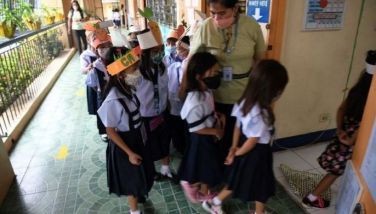‘Donate hair, save the environment’
August 19, 2006 | 12:00am
 Greenpeace International issued an appeal to hairdressers and beauty salons yesterday to donate cut hair for a worthy cause, saying indigenous materials such as human hair can be used to absorb the oil spill off Guimaras island.
Greenpeace International issued an appeal to hairdressers and beauty salons yesterday to donate cut hair for a worthy cause, saying indigenous materials such as human hair can be used to absorb the oil spill off Guimaras island.
Greenpeace campaigner Athena Ballesteros said other indigenous materials such as cogon and rice straw could also act as oil
absorbents even as the group stressed that hair cut today could save the environment tomorrow.
The environment group also encouraged everyone, including local government units, residents and all donors to give relief items particularly food to help the affected families.
They require shoreline cleaning materials and equipment such as ocean boom/fence boom, tents, protective gears, rubber boats, hand/rubber gloves, face masks and shovels.
They also need plastic bags, sacks, fast tanks, water-resistant canvass, food packs for workers, generators, oil dispersants, bag pack sprayer, and high pressure hose with hot pressured motor.
Meanwhile, the environmental group is expected to deliver today some 1,000 sacks of relief goods and basic cleanup equipment to the containment and recovery efforts of the Philippine Coast Guard
(PCG) on Guimaras island to prevent the recent oil spill from further contaminating the marine life in the area.
Von Hernandez, Greenpeace Southeast Asia director campaigner, said despite running a tight schedule, they agreed to assist the PCG to contain the oil spill near Guimaras. They left South Harbor in
Manila at around 2 p.m. yesterday and would arrive at the Iloilo Port at 2 p.m. today. The 72-meter M/Y Esperanza and its 19 crew members would stay in the area for three days.
At the site, the Esperanza will perform four tasks including the transport of relief goods donated by the ABS-CBN Foundation and other donors and bring cleanup and containment equipment to PCG units on the ground. The food would be brought to the affected fisherfolk who have lost their livelihood because of the contamination.
The environmental group would also conduct a joint visual survey with the PCG specifically in the southeastern tip of Guimaras Island, the worst hit area and where a protected marine sanctuary has been badly devastated; and work with scientists and other marine/ecology experts to undergo impacts assessment and determine the damage caused by the oil spill to important marine sanctuaries and coastal ecosystems in the area.
"We could also look at the ground zero, where the vessel sank," Hernandez said. Esperanza crew member, British national Gavin Newman who is already at the site and is said to be an industrial diver, has been commissioned as expedition photographer.
They also have yet to check if the ship carried a submersible camera and if it can go down to 3,000 feet, where the ship has sunk, to visualize what happened. The PCG divers can only dive up to 120 feet deep because they do not have the proper equipment.
Greenpeace initially dispatched a 10-man team to monitor and document the oil spill and they have mobilized about 50 to 100 volunteers.
Hernandez said their side trip to Guimaras coincides with their "Defending the Oceans" worldwide tour.
"In this case, the PCG is candid enough to say that they need support because their resources are very limited," said Hernandez. He added that this was not the first time that they are working with government agencies.
LtCmdr. Joseph Coyme, PCG Task Force Guimaras Oil Spill (TFGOSP) spokesman, said they had been soliciting help even from foreign companies and organizations that may have the capability to remove the oil that leaked from one of the 10 cargo holds of the M/T Solar 1 since last Aug. 11. Each cargo hold reportedly contained 100,000 liters of bunker oil. The tanker carried a total of 2.1 million liters of bunker oil.
Coyme expressed his gratitude to the environmental group for extending assistance. Even if "their stay in the Philippines is limited, their short stay will have an impact not only in our country but has a global perspective as well."
Hernandez said this incident, which is regarded as the largest oil spill in Philippine history, is both an environmental and economic disaster because there are persistent chemicals in oil, such as hydrocarbon. Once it settles on the coral reefs, it would kill the corals that serve as a nursing and feeding ground for fishes and other marine life.
BrandSpace Articles
<
>
- Latest
Latest
Latest
December 14, 2024 - 11:22am
By Karry Sison | December 14, 2024 - 11:22am
December 9, 2024 - 2:53pm
By Rupert Paul Manhit | December 9, 2024 - 2:53pm
December 8, 2024 - 9:00am
By Jing Castañeda | December 8, 2024 - 9:00am
November 30, 2024 - 5:19pm
By Joanna Perfecto | November 30, 2024 - 5:19pm
November 23, 2024 - 6:23pm
By Rupert Paul Manhit | November 23, 2024 - 6:23pm
November 23, 2024 - 1:52pm
By Edilberto de Jesus | November 23, 2024 - 1:52pm
Recommended


























